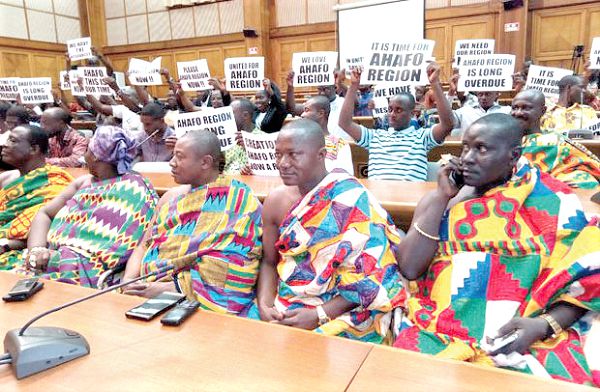
Ahafo Region has potential to flourish
December 27 is inching closer and registered voters in the six proposed new regions are girding up their loins to go to the polls in a referendum to confirm or reject the creation of the regions.
Recent visits I made to my native Ahafo revealed that expectations are very high. In the six administrative municipalities/districts — Asunafo North, Asunafo South, Asutifi South, Asutifi North, Tano North and Tano South — the chiefs and other community leaders are in the thick of affairs educating their people on the need to vote ‘Yes’ on the referendum day.
Advertisement
In Accra, where I live, members of the Ahafo Citizens Association have also been preparing feverishly for the polls and the eventual inauguration of a new region. And, in Kumasi, a group led by my friend and accountant with the Social Security and National Insurance Trust (SSNIT), Mr Stephen Owusu Gyamfi aka Glabus is also working towards making the referendum a success.
Naturally, my interest in the referendum lies in Ahafo and I expect our people to be guided by the unimpressive development trajectory to vote a massive "Yes" to see the birth of a new region, which the people have been yearning for since the 1970s.
Chequered history
Ahafo has had a chequered history since the first settlers set foot on the land in the 18th century .
Documented history and oral tradition seem to agree about the period in which people started to settle on the land.
My childhood friend at Goaso and now a Professor of History at the University of Cape Coast, Prof. Kwame Osei Kwarteng, who has written extensively about Ahafo, has in a book titled, "A History of Ahafo from 1719 to 1959: Ahafo from dependence to independence", examined the history of Ahafo from the earliest times to the creation of the Brong Ahafo Region in 1959.
He said : "The period between the conquest of Ahafo lands by the Asante warriors in the early 18th century and the mid–20th century has not had any serious and detailed historical studies.
Therefore, Ahafo still awaits an in-depth and serious historical investigation."
It was in that context that the historian, in his book, had done a critical work on Ahafo from the period of the Asante wars of conquest and expansion when the land that is called Ahafo was uninhabited.
"The work include the Abirimoro war, the subsequent establishment of the Ahafo settlements as Asante dependencies, the places of origin of the Ahafo people, their overlords and the landlords from whom permission was sought for the settlement, the functions of the dependencies, how they were governed, the involvement of the Ahafo in civil wars in Asante, Anglo–Ahafo relations and the British provision of a freedom charter to Ahafo, the autonomy of Ahafo division and the restoration of Asante Confederacy," Prof. Kwarteng wrote .
Wars of expansion
Clearly, the emergence of Ahafo has its roots in the Asante wars of expansion led by Asantehene Opoku Ware 1.
A warrior extraordinaire, Opoku Ware led the Asante army to win lands as the Asante Kingdom expanded to the west .
The Asantes sent some people to take care of the lands they seized and to maintain a stranglehold on the lands, the Asantes set up camps that developed into villages and eventually into towns like Goaso, Kenyase, Mim, Hwidiem, Acherensua, Nkaseim, Akrodie, Bechem and Dadiesoaboa.
Birth of Brong Ahafo
Since the creation of the Brong Ahafo Region in 1959, the Ahafo area has seen some measure of development but suffice it to say that the level of progress does not measure up to the abundant natural resources of the area.
The vast Ahafo is noted for the production of plantain, cocoyam, cocoa, gold and timber but these resources have not translated into socio-economic development of the communities.
Infrastructure development is nothing to write home about.
Many of the roads especially to the cocoa growing areas are in bad state Poverty is still high and many of the youth have moved to the cities in search for non-existent jobs.
Hard work
The creation of Ahafo Region will be a huge step towards securing the development dream of Ahafo but, the reality is that, the creation alone will not guarantee the progress the people are anticipating.
It will demand unity, fortitude and industry on the part of the people.
Over the years, unnecessary divisions among some of the towns and traditional rulers have inhibited progress .
Many of our people have also failed to identify with their towns and have preferred associating with the Asante towns from where they trace their roots.
It is also distasteful that revenues accruing to some of the stools have not been put to productive use .
In is important for leaders to leave worthy legacies but some leaders do not leave a legacy at all, and in the end, they are never remembered again when they leave the scene, or even when they die .
Others leave negative legacies and their names will constantly be bastardised long after they have left the scene.
But, others leave remarkable legacies that will be lived on for years.
Our leaders have the duty to galvanise their people to complement the efforts of government in the development agenda and they cannot afford to fail when Ahafo Region is born.




